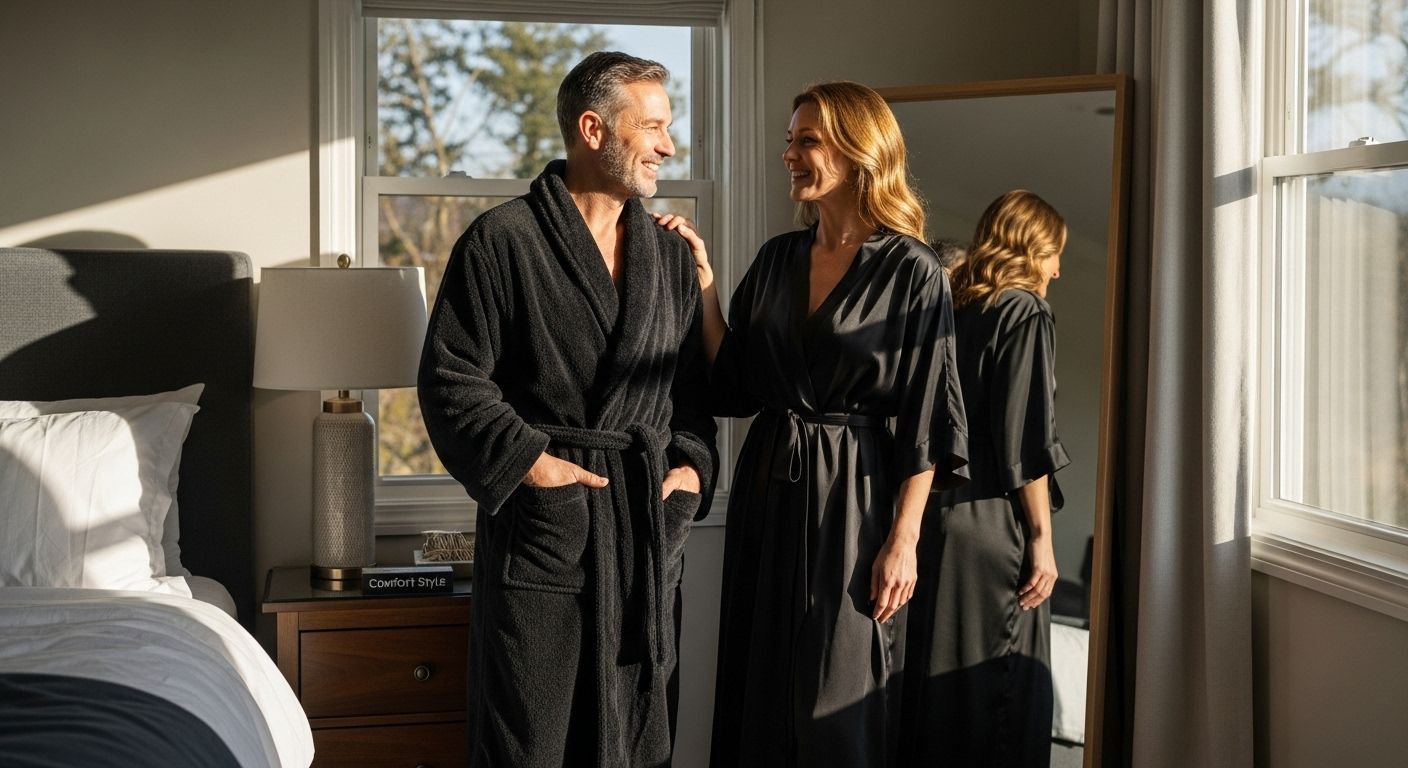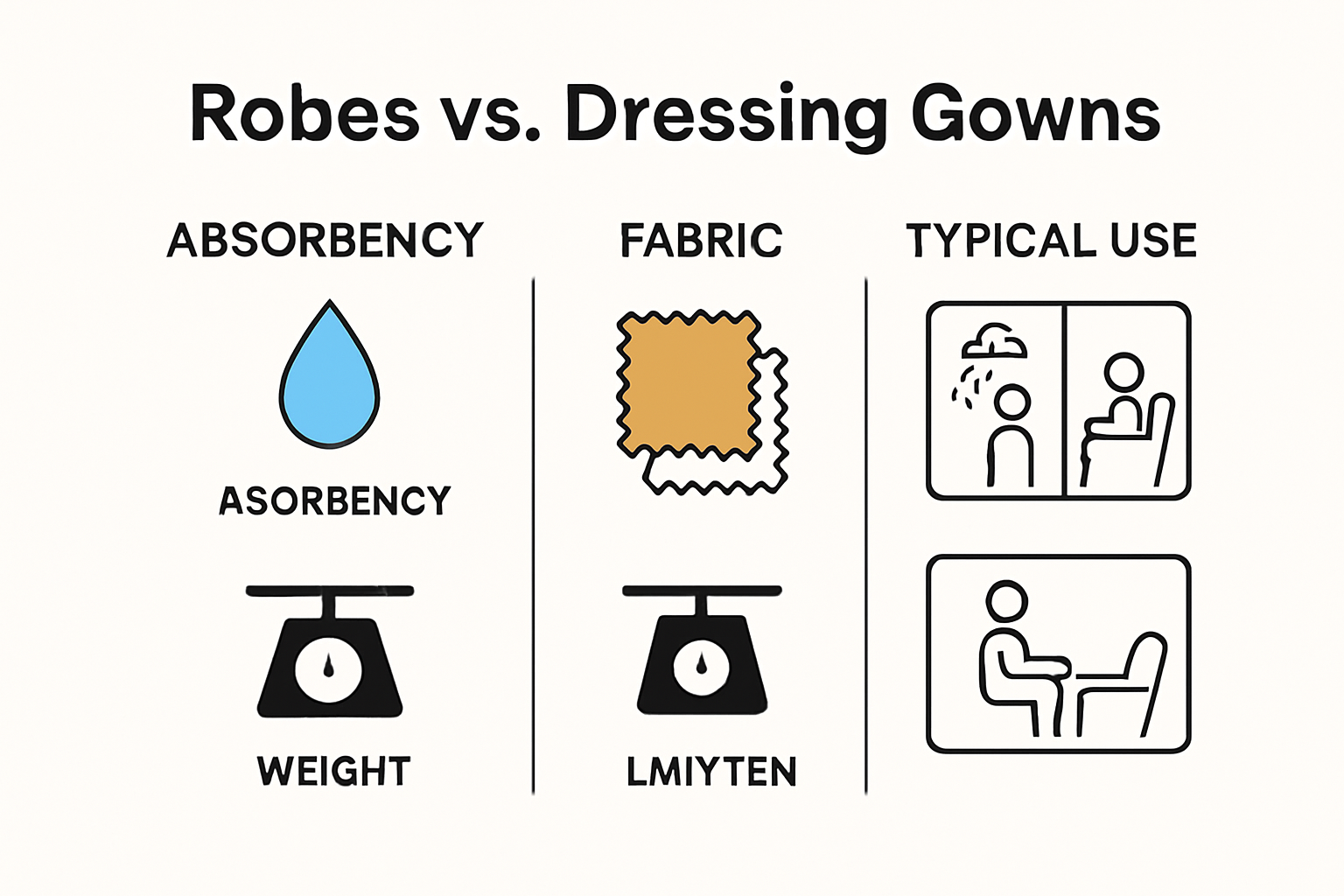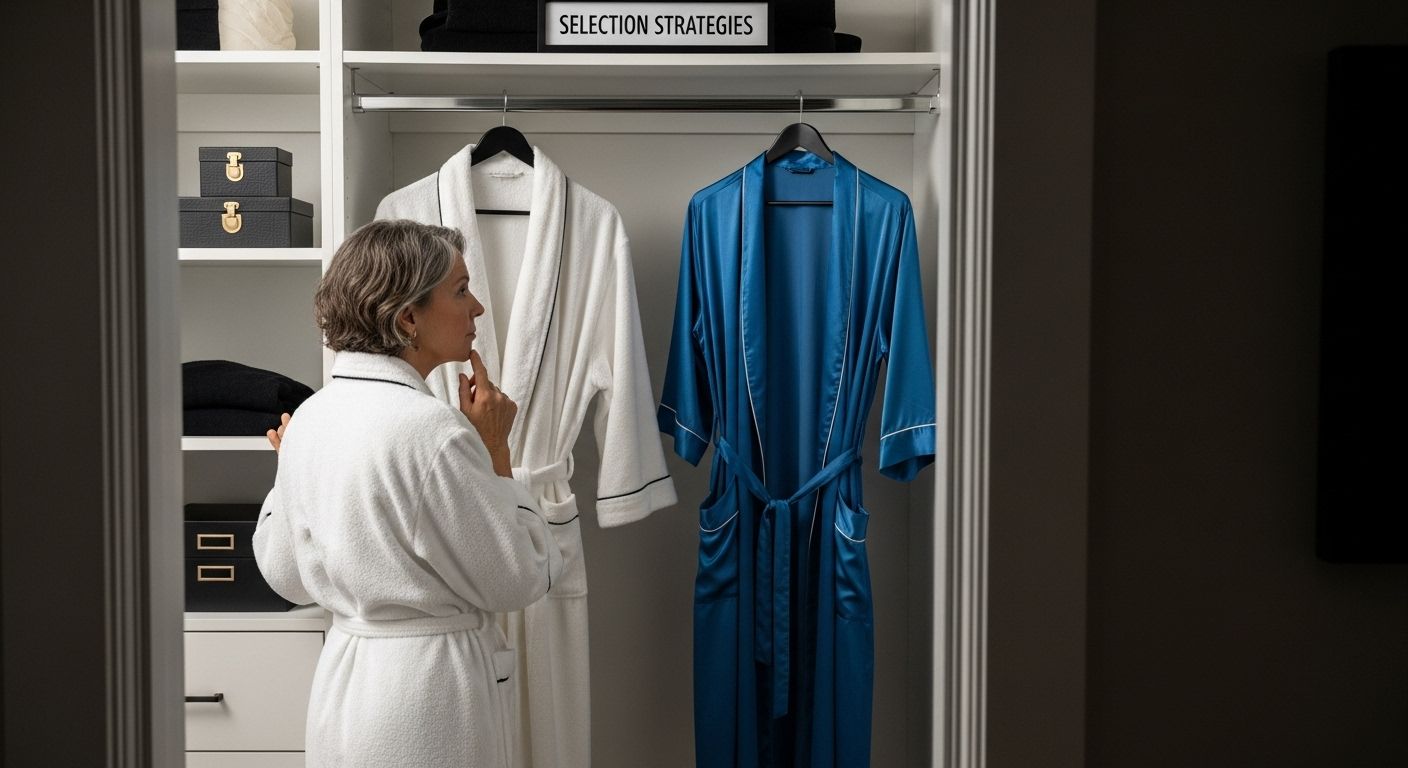
Robes and dressing gowns might look similar at first glance, but choosing the right one can completely change the way you relax at home. Here is something most people miss. Robes are actually designed to be more functional and absorbent, making them ideal for post-shower comfort, while dressing gowns focus on elegance and lightness. The real surprise? As we head into 2025, sustainable fabrics and new features are making both options better than ever, so your comfort choices go far beyond old-school cotton and terry cloth.
Table of Contents
- Robes Vs Dressing Gowns Defined Simply
- Key Differences In Style And Comfort
- Top Uses For Home, Hotels, And Gifting
- Tips For Picking The Perfect Option In 2025
Quick Summary
| Takeaway | Explanation |
|---|---|
| Robes are more functional than dressing gowns | Robes typically use absorbent materials, making them ideal for post-bathing comfort and practicality. |
| Dressing gowns prioritize elegance and comfort | Crafted from lightweight fabrics, dressing gowns offer a refined look for relaxation without the absorption focus. |
| Consider personal lifestyle when selecting | Your choice should reflect daily routines, climate conditions, and personal style preferences for optimal comfort. |
| Robes and dressing gowns serve diverse purposes | Both can enhance home comfort, elevate hospitality experiences, and make meaningful gifts for various occasions. |
| Opt for sustainable materials in 2025 | With a greater variety of eco-friendly options available, selecting robes or gowns made from sustainable fabrics benefits you and the planet. |
Robes vs Dressing Gowns Defined Simply
Understanding the subtle differences between robes and dressing gowns can transform your loungewear experience. While these terms are often used interchangeably, they actually represent distinct types of comfortable clothing with unique characteristics and purposes.
Defining the Terms: What Sets Them Apart
Merriam-Webster defines a dressing gown as a garment worn primarily during dressing or resting periods. This definition highlights the primary function of a dressing gown as a loose, comfortable piece of clothing designed for personal relaxation and preparation.
In contrast, a robe encompasses a broader range of styles and functions. According to Wikipedia, a bathrobe or robe is typically an absorbent outer garment worn after bathing, swimming, or as a comfortable lounging piece. The key distinction lies in the material and intended use.
Practical Differences in Design and Function
Dressing gowns are generally lighter and less absorbent compared to traditional robes. They often feature more refined materials like silk, lightweight cotton, or delicate fabrics that prioritize comfort and aesthetic appeal. These garments are perfect for leisurely mornings, quick transitions between activities, or simply adding a touch of elegance to your home attire.
Robes, particularly bathrobes, are engineered for functionality. They are typically made from terry cloth, microfiber, or other highly absorbent materials designed to help you dry off after bathing or swimming. The construction focuses on practicality, with features like thick fabric, water-absorbing capabilities, and often a more relaxed fit.
Choosing Your Ideal Comfort Companion
Selecting between a robe and a dressing gown depends on your specific needs and lifestyle. If you’re looking for something to wear immediately after a shower or pool session, a plush, absorbent robe is your best bet. For those seeking a sophisticated loungewear piece for relaxing at home, reading, or enjoying a leisurely breakfast, a dressing gown offers the perfect blend of comfort and style.
Consider factors like fabric weight, material composition, and your personal comfort preferences. Some individuals might prefer a lightweight silk dressing gown for warmer environments, while others might opt for a thick terry cloth robe in cooler settings. The beauty of modern loungewear is the incredible variety available to suit every taste and requirement.
Ultimately, whether you choose a robe or a dressing gown, the goal is the same: to create a personal sanctuary of comfort that reflects your individual style and enhances your daily relaxation routine.
Key Differences in Style and Comfort
The world of loungewear presents a fascinating spectrum of comfort and style, particularly when comparing robes and dressing gowns. Understanding the nuanced differences in design, material, and purpose can help you make an informed choice that perfectly suits your lifestyle and personal preferences.
Material Composition and Texture

Research from Wikipedia reveals that bathrobes are typically constructed from highly absorbent materials like terrycloth or cotton, engineered to efficiently wick moisture and provide warmth after bathing. In contrast, dressing gowns are crafted from lighter, more elegant fabrics such as silk, satin, or lightweight cotton, prioritizing aesthetic appeal and comfort over moisture absorption.
The texture difference is significant. Bathrobes offer a plush, thick feel that envelops you in softness, making them ideal for post-shower moments or lounging around after swimming. Dressing gowns, with their smoother and more refined textures, provide a more sophisticated lounging experience that feels elegant and understated.
To help you better distinguish between robes and dressing gowns, here’s a table summarizing their key differences in materials, texture, and intended use:
| Feature | Robe (Bathrobe) | Dressing Gown |
|---|---|---|
| Common Materials | Terry cloth, cotton, microfiber | Silk, satin, lightweight cotton |
| Texture | Plush, thick, absorbent | Smooth, light, elegant |
| Primary Purpose | Post-bath/shower, moisture absorption | Leisure, style, lounging |
| Typical Fit | Relaxed, oversized | Tailored, structured |
| Main Features | Highly functional, warm, practical | Refined details, aesthetic appeal |
| Common Usage | After bathing, pool, spa, home comfort | Over nightwear, lounging, morning routine |
Functional Design and Versatility
According to comparative research, bathrobes are substantially more functional and commonly used compared to traditional dressing gowns. Their design focuses on practicality, with features like increased fabric weight, superior absorption capabilities, and a more relaxed fit that accommodates movement.
Dressing gowns, by comparison, are designed with a more tailored approach. They often feature refined details like delicate belts, elegant lapels, and a more structured silhouette. These garments are less about utility and more about creating a sense of refined leisure, perfect for wearing over nightwear or during casual morning routines.
Comfort Contexts and Personal Expression
Choosing between a robe and a dressing gown is ultimately a personal decision that reflects individual lifestyle, comfort needs, and aesthetic preferences. A thick, terry cloth bathrobe might be perfect for someone who values immediate post-shower comfort and warmth. Conversely, a silk dressing gown could be ideal for someone seeking a touch of luxury during morning coffee or evening relaxation.
Consider your daily routines, climate, and personal style when making your selection. Do you prioritize maximum absorbency and warmth, or are you more interested in a lightweight, elegant loungewear piece? The beauty of modern loungewear is its diversity, offering solutions for virtually every comfort scenario.
Whether you gravitate towards the practical embrace of a bathrobe or the refined elegance of a dressing gown, the most important factor is how the garment makes you feel. Comfort is not just about physical sensation but also about emotional well-being and personal expression.
Top Uses for Home, Hotels, and Gifting
Robes and dressing gowns have transcended their traditional boundaries, becoming versatile garments that serve multiple purposes across different environments. From creating comfort at home to enhancing hospitality experiences and serving as thoughtful gifts, these loungewear pieces have become essential in various settings.
Home Comfort and Personal Wellness
Wikipedia highlights that bathrobes are fundamentally designed for personal comfort, providing warmth and modesty after bathing or during relaxed home moments. They transform ordinary spaces into personal sanctuaries of relaxation. For individuals seeking a blend of functionality and comfort, robes offer an unparalleled experience of post-shower warmth and leisurely transition between activities.
Dressing gowns complement home environments differently. As noted in research, these garments are perfect for lounging, offering a more refined aesthetic while maintaining comfort. They serve as elegant alternatives to traditional home attire, allowing individuals to feel put-together even during casual moments.
Hospitality and Luxury Experiences
The International Luxury Hotel Association explains that robes play a crucial role in elevating guest experiences. High-quality robes are not merely amenities but strategic tools for creating memorable stays. Hotels and resorts use these garments to communicate luxury, comfort, and attention to detail.
Boutique hotels and spa retreats often customize robes to reflect their brand identity, transforming a simple piece of clothing into a marketing instrument. Guests frequently associate the quality of provided robes with the overall standard of accommodation, making them a subtle yet powerful aspect of hospitality design.
Gifting and Personal Celebrations
Robes and dressing gowns have emerged as sophisticated gifting options for various occasions. Bridal parties, housewarming celebrations, Mother’s Day, and personal milestone events present perfect opportunities to gift these versatile garments. The key is selecting a piece that reflects the recipient’s personal style and comfort preferences.
Personalization has become a significant trend in robe gifting. Embroidered names, custom colors, and tailored fits transform these garments from simple clothing items into meaningful, cherished presents. For wedding parties, matching robes create memorable photographic moments and serve as lasting mementos of shared experiences.
When selecting a robe or dressing gown as a gift, consider the recipient’s lifestyle, aesthetic preferences, and practical needs. A plush terry cloth robe might suit someone who values post-shower comfort, while a silk dressing gown could delight someone who appreciates elegant loungewear.
Ultimately, robes and dressing gowns represent more than just clothing. They are personal comfort statements, hospitality symbols, and thoughtful expressions of care that transcend their basic functional purpose. Whether used at home, in luxury hotels, or given as heartfelt gifts, these garments continue to evolve, reflecting our collective desire for comfort, style, and personal expression.
To showcase the most common uses for robes and dressing gowns, here’s a table summarizing their main applications in different settings:
| Application Setting | Robe (Bathrobe) | Dressing Gown |
|---|---|---|
| Home | Post-shower comfort, warmth, relaxed transition | Elegant lounging, morning/evening routines |
| Hotels/Spas | Luxury amenity, branding, guest experience | Rare, sometimes as luxury loungewear |
| Gifting | Spa gifts, bridal parties, milestones, personalization | Housewarming, birthdays, elegant celebrations |
Tips for Picking the Perfect Option in 2025
Navigating the world of robes and dressing gowns in 2025 requires a strategic approach that balances personal comfort, style, and emerging trends. The loungewear landscape has evolved, offering more sophisticated and personalized options than ever before.
Fabric and Material Considerations
According to the Liverpool Buzz guide, 2025 presents an exciting array of fabric choices for robes and dressing gowns. Sustainable materials are taking center stage, with options ranging from organic cotton and bamboo fibers to recycled microfiber blends. Each fabric offers unique benefits:
- Terry cloth: Excellent for maximum absorption and post-shower comfort
- Waffle weave: Lightweight and quick-drying
- Microfiber: Soft, lightweight, and ideal for travel
- Modal: Eco-friendly, breathable, and incredibly soft
Consider your primary use when selecting fabric. For those seeking maximum moisture absorption, terry cloth remains the top choice. For individuals prioritizing lightweight comfort and environmental consciousness, modal or recycled microfiber options provide excellent alternatives.
Design and Functionality Trends
Research from The Towel Shop highlights the importance of selecting a design that matches your lifestyle. In 2025, robes and dressing gowns are moving beyond traditional concepts, incorporating innovative features:
- Gender-neutral designs that prioritize universal comfort
- Smart technology integration like temperature-regulating fabrics
- Customization options for personalized fit and style
- Versatile designs that transition from lounge to street wear
Pay attention to practical details like belt design, pocket placement, and length. A well-designed robe or dressing gown should provide comfort, functionality, and a touch of personal expression. Hooded designs offer additional warmth and convenience, especially for those who prefer comprehensive coverage after bathing.
Practical Selection Strategies

Selecting the perfect robe or dressing gown in 2025 requires a holistic approach. Consider these strategic selection criteria:
- Body measurements: Ensure a comfortable, flattering fit
- Climate considerations: Choose lighter fabrics for warm environments, thicker materials for cooler regions
- Intended use: Differentiate between post-shower, lounging, and potential outdoor use
- Maintenance requirements: Evaluate care instructions and fabric durability
Budget plays a crucial role, but remember that investing in a high-quality piece can provide long-term comfort and satisfaction. Look for brands that offer a balance between innovative design, sustainable practices, and reasonable pricing.
Ultimately, the perfect robe or dressing gown is a personal choice that reflects your individual style, comfort needs, and lifestyle. By understanding the latest trends and focusing on quality and functionality, you can find a loungewear piece that not only meets your practical requirements but also makes you feel confident and comfortable.
Frequently Asked Questions
What is the difference between a robe and a dressing gown?
Robes are typically designed for functionality and absorption, making them ideal for post-shower comfort, while dressing gowns focus on elegance and lightness for leisurely wear.
What materials are commonly used for robes and dressing gowns?
Robes are often made from absorbent materials like terry cloth or cotton, whereas dressing gowns are crafted from lighter fabrics such as silk, satin, or lightweight cotton to prioritize comfort and style.
When should I choose a robe over a dressing gown?
Opt for a robe if you need something practical for after bathing or swimming, as it offers warmth and moisture absorption. A dressing gown is best for leisurely activities at home, providing a more sophisticated look.
What features should I consider when buying a robe or dressing gown in 2025?
In 2025, look for fabrics that are sustainable, innovative designs that may include smart technology, customization options for fit, and consider your climate and intended use to select the most suitable option.
Experience Personalized Comfort with Lotus Linen
Still deciding between the functional warmth of a robe and the elegant touch of a dressing gown? If you struggle to find loungewear that delivers both comfort and style—especially with the latest sustainable and customizable options—your search ends here. At Lotus Linen, you will discover robes tailored for absorbency after your shower, as well as sophisticated dressing gowns for those leisurely mornings. Our collection covers every preference mentioned in the article, featuring premium fabrics like plush terry, waffle weave, and soft cotton, and offering personalization to reflect your unique taste.

Create your own comfort sanctuary today. Discover the full range of innovative robe and loungewear solutions at Lotus Linen. Elevate your relaxation routine and enjoy quality that lasts—explore your new favorite robe or dressing gown now before the 2025 designs are gone.
Recommended
-
[ Why Use Bathrobes? Comfort, Style & Gift Trends for 2025
– Lotus Linen
](https://www.shoplotuslinen.com/blogs/news/why-use-bathrobes-comfort-luxury-gift-trends-2025)
-
[ Best Towels & Bathrobes
– Lotus Linen
](https://www.shoplotuslinen.com/blogs/news/ultimate-guide-on-how-to-choose-best-towels-and-bathrobes)
-
[ Top 10 Most Luxurious Bathrobes
– Lotus Linen
-
[ Bathrobe vs Dressing Gown: Best Choice for Comfort and Style 2025
– Lotus Linen
](https://www.shoplotuslinen.com/blogs/news/bathrobe-vs-dressing-gown-best-comfort-style-2025)
